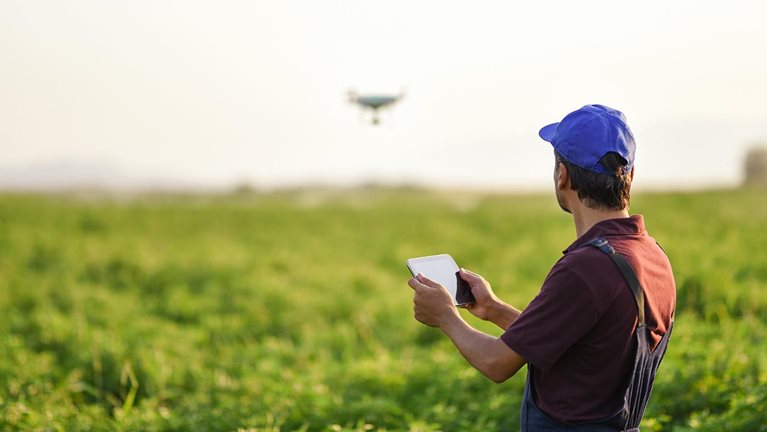It’s a dire statistic: 33 to 40 percent of the world’s food is lost or wasted every year. A devastating fact in less desperate times, it takes on even greater urgency today, in light of a looming global food crisis resulting from knock-on effects of the war in Ukraine, COVID-19, and climate change. Already, one in nine people in the world can’t get enough to eat—that’s more than 800 million suffering from hunger. The consequences of food loss and waste will only get worse. (“Food loss” happens at harvest or soon after, while “food waste” happens after the food reaches the retailer or consumer. See sidebar, “Is food loss the same as food waste?”)
The loss of the food itself is bad enough, but the secondary effects are alarming as well: the water consumption linked to food loss and waste amounts to approximately one-fourth of the world’s freshwater supply. Greenhouse-gas (GHG) emissions from food loss and waste constitute 8 percent of the global total, or at least four times those of the aviation industry.
To date, most large-scale efforts to understand and address the problem have focused on food waste, largely because it’s more visible: people see food being wasted in stores, restaurants, and households. But up to half of the food that doesn’t get eaten by humans—worth an estimated $600 billion—is lost at or near the farm, during or just after harvest. Reducing food loss should therefore be treated as a societal and environmental priority.
It should become a business priority as well. Our in-depth examination of the farm-to-retailer food supply chain reveals that food loss is a result of inefficiencies, and its hidden costs are often equal to or greater than retailers’ net profit—even the best-performing ones.
The good news is that reducing food loss is immensely achievable. Our research shows that food manufacturers and retailers, because they are at the center of the food value chain, are uniquely positioned to lead global efforts to reduce food loss. Working with each other and with all participants in the value chain, we believe they could cut food loss by 50 to 70 percent. Two-thirds of the food that would otherwise be lost could be redirected to human consumption; the remaining one-third would go to alternative uses, such as bio-based materials or animal feed.
And the business rewards would be significant: companies would reap economic and cash flow benefits while simultaneously improving their scope 3 emission footprint. Our research shows that retailers could reduce their cost of goods sold (COGS) by 3 to 6 percent, manufacturers by 5 to 10 percent. Grocers and manufacturers could capture $80 billion in new market potential by developing new businesses from food that would otherwise be lost. And they could cut CO2 emissions and the associated costs by 4 to 9 percent.
Because food loss is a sprawling problem that spans multiple players and processes, siloed approaches will have limited impact. To effect major change, all stakeholders will need to work together. The effort and investment will be well worth it, on many levels.
Where and how does food get lost?
More than two billion tons of food are lost or wasted every year. About half of this happens upstream: during the harvest, postharvest handling and storage, and processing stages (Exhibit 1).

Although meat and dairy have a high environmental impact per unit produced (it takes more than 1,000 gallons of water to produce a pound of beef, for example), meat accounts for only about 3 percent of food loss; dairy another 5 percent. Three other food categories—fruits and vegetables, cereals, and roots and tubers—account for much of the food loss and the associated CO2 emissions and water use (Exhibit 2). Those categories should therefore be the focus of loss reduction efforts.

Exactly where in the supply chain does food get lost, and what factors contribute to this? In collaboration with the Consumer Goods Forum and its members, and working closely with leading European grocers and distributors, we investigated the farm-to-retailer journey, using tomatoes as our test case.
We chose tomatoes because 50 million to 75 million tons of them are lost upstream every year—more than any other fruit or vegetable. In addition, lessons learned from the tomato’s journey can be extrapolated to other fresh-produce categories. Tomatoes are grown and eaten all over the world, are available year-round, can be eaten fresh or go through further processing, must conform to certain cosmetic standards (color, shape, and so forth), and resemble several other produce categories with regard to perishability.
We studied tomato journeys in both developed and developing markets—tomatoes sold fresh and those sent into the processed supply chain, and tomatoes grown in fields as well as in developed-market greenhouses. Exhibit 3 illustrates what happens to tomatoes grown in fields in developed markets and sent to retailers to be sold fresh in their stores. As the exhibit shows, in developed countries, out of every 100 tomatoes only 59 to 72 make it to a store shelf. In the developing world, the numbers are grimmer: only 35 to 58 make it to the store.
At harvest, we estimate that one-third of the loss is linked to production surplus (the farm produced more food than it could sell), another third consists of food that is edible but doesn’t meet customer specifications, and the remaining third is because of damage that renders the food inedible. In short, two-thirds of the loss is edible and could be safely redirected to human consumption.
Our research revealed that some food loss results from exogenous factors, such as weather events, or suboptimal practices within a specific stage of the supply chain, such as poor equipment maintenance—but some loss is linked to the interdependencies and interactions among the players in the value chain. Growers may overproduce because they are uncertain about market demand, while manufacturers and retailers often don’t have much transparency into supply. Stringent customer specifications can lead to excessive postharvest outgrading.1 Most procurement contracts don’t create incentives for reducing food loss.
Solving the food loss problem will therefore require fundamental changes in the ways that stakeholders work together. For tomatoes alone, the potential impact is more than 40 million tons saved every year. Globally, CO2 emissions linked to tomato loss would fall by 60 to 80 percent. And if this can be done with tomatoes, it can be done with other food categories as well.
How companies can turn food loss into big wins
Since food loss happens primarily at the farm, what can food manufacturers and grocers do about it? Quite a lot, it turns out. An effective action plan would entail, first, establishing a baseline and setting targets; then systematically developing and implementing initiatives; and, finally, putting in place the enablers for lasting change.
Ultimately, addressing food loss will require mindset shifts by all stakeholders. Food manufacturers and retailers will need to see food loss as a result of inefficiencies and missed opportunities across production, procurement, R&D, the supply chain, and sales—not as an inevitable cost of doing business or a niche topic that concerns only the sustainability department. They should see reducing food loss as a potential value pool: an opportunity to improve both the top and bottom lines.
Create transparency and set targets
Quantifying food loss and creating accountability for it aren’t (yet) an exact science; the measurement techniques and metrics are still being defined and debated. But that’s no excuse for companies to do nothing. If you are a grocer or a food manufacturer, aim to gather directionally accurate information through a range of sources and techniques, such as interviewing internal teams, examining data from suppliers, and reviewing third-party research. Work with your suppliers to understand and monitor food loss, perhaps using the on-farm food loss measurement protocols readily available online. Set targets for both your own company and suppliers, and integrate food loss visibility and reduction into incentive structures. Stay aware of—or, even better, participate in—industry efforts to harmonize reporting and certification standards.
Forward-thinking companies are actively engaging with suppliers to map food loss “hot spots” in the supply chain and to understand their causes. Some companies are developing (and providing public access to) an integrated database of suppliers’ performance across locations. Others are conducting an annual external audit or requiring third-party assessment of suppliers’ performance on this issue. A few best-practice companies are using digital technologies, like blockchain, to make products traceable at every stage along the journey from farm to store.
Don’t wait for perfect data; just gather enough information to sense the scope of the problem. Generating awareness of how much loss happens—and where—is an important first step in creating urgency for change.
Decide what to do—and do it
Our research revealed four levers that retailers and food manufacturers can pull to make meaningful impact: minimizing loss during production and processing, minimizing loss during transit, selling more of what is produced, and structurally preventing loss (Exhibit 4). Each lever comprises a set of potential actions. Some will require significant investment and new ways of working. All will pay off, resulting in not just a reduction in food loss but also a more efficient value chain, EBITDA improvements, and lower CO2 emissions.

No single combination of levers will be right for every company; each stakeholder will need to select the mix that best fits its particular context. Exhibit 5 shows examples of food loss programs that a food manufacturer or a retailer could implement.

Regardless of the chosen course of action, each company must fundamentally change how it interacts with other stakeholders in the food ecosystem. The following are specific ways in which manufacturers and retailers can go against business-as-usual approaches and make big strides toward addressing food loss:
Work with suppliers to better match supply and demand. This will require much more communication and transparency among the players in the value chain. Retailers will need to give farmers more information about expected demand; farmers will need to give retailers more visibility into their production plans. Some companies are starting to engage in long-term planning with their suppliers, working together to align on the volume and mix of crops—not just for the upcoming planting season but also for the next one and the one after that—thereby reducing uncertainty for the parties involved.
Overhaul procurement practices. How you buy must change dramatically. Shift away from a commoditized view of food and a focus on managing short-term costs; instead, consider launching structured supplier collaboration efforts or entering into innovation-focused partnerships. Don’t choose suppliers based on price alone. Take food loss reduction efforts into account when drawing up contracts, creating incentive structures, and establishing performance metrics. In addition, regularly review specifications and look for opportunities to make them less stringent, without compromising food safety or sell-through. (For example, through consumer surveys, grocers might find that consumers have a higher tolerance for color variations than in the past, or that shoppers don’t pay much attention to the size of a particular fruit variety.) For manufacturers, reviewing specifications to optimize for loss reduction both at the farm and at the factory could lead to lower volume requirements.
Find creative ways to turn food loss into value. There is enormous potential to sell more of the food that farmers produce. Food that would otherwise be lost can be turned into new products and thriving businesses. Consider dedicating R&D resources to developing new revenue streams from nonmarketable food. AB InBev, for instance, invested $200 million in processing plants to turn its barley byproducts into a protein and fiber ingredient. It developed two new businesses as a result: a dairy-free protein drink sold under the Canvas brand and a protein ingredient that AB InBev now sells to other food manufacturers.
Enable true and lasting change
At any company, food loss reduction won’t be treated as a strategic priority unless it has the sponsorship of the C-suite. Indeed, in an informal poll of a dozen industry leaders, two-thirds pointed to weak governance as the biggest roadblock to the implementation of food loss programs in their companies.
One of the most important enablers for significant and sustained change, therefore, is a strong governance model—with cross-functional accountability encompassing procurement, R&D, the supply chain, manufacturing, marketing, and finance; clear responsibilities and objectives; and KPIs at the individual, functional, and enterprise level. Designating an owner for each food loss initiative and aligning on measures of success will help ensure progress. New performance metrics might include, for instance, the volume of food lost, the profit from upcycling, or the revenue gained from saving food that would otherwise be lost.
Stakeholder management, too, is a critical enabler. Suppliers, consumers, and other participants in the value chain can be persuaded to become allies and supporters of loss-reduction efforts rather than inhibitors. Manufacturers and grocers can create and raise awareness of the problem—and its extent—among farmers and suppliers, to help them see food loss as an inefficiency instead of an inevitability. On the consumer side, targeted marketing programs and educational campaigns can help consumers understand how to reduce food loss, which could in turn enable the implementation of upstream measures, such as less-exacting cosmetic specifications for fresh produce.
At most companies today, the unfortunate reality is that food loss is no one’s problem. No individual or team owns and champions the issue. In a sense, companies have had the luxury of not having to pay too much attention to food loss. That could soon change: as the world moves toward a potential food emergency and as public awareness of the issue grows, external stakeholders will become savvier about food loss and, as a result, more demanding. They will compel retailers and manufacturers to act. Simply put, addressing food loss now isn’t just a good thing to do; it’s also good business—and soon it won’t be optional.


